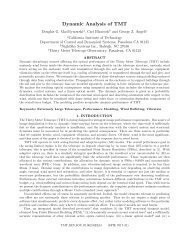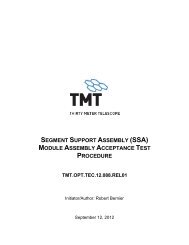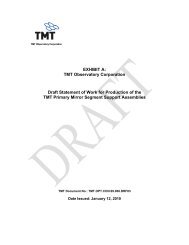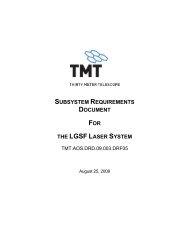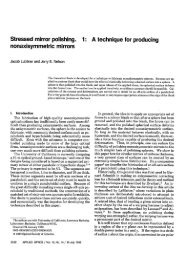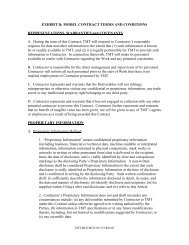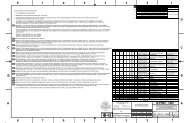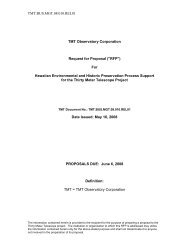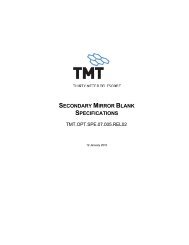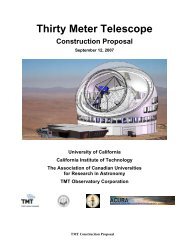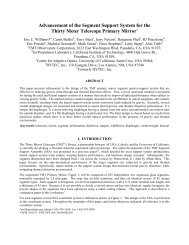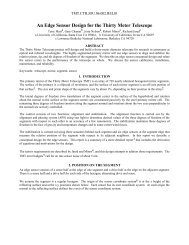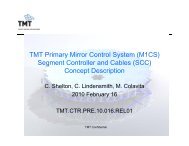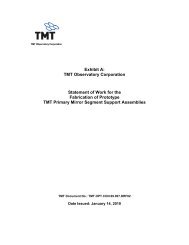TMT Optics Discussions with Industry - Thirty Meter Telescope
TMT Optics Discussions with Industry - Thirty Meter Telescope
TMT Optics Discussions with Industry - Thirty Meter Telescope
You also want an ePaper? Increase the reach of your titles
YUMPU automatically turns print PDFs into web optimized ePapers that Google loves.
<strong>TMT</strong><br />
<strong>Telescope</strong> <strong>Optics</strong><br />
Eric Williams<br />
<strong>Discussions</strong> <strong>with</strong> <strong>Industry</strong><br />
November 2009<br />
<strong>TMT</strong>.OPT.PRE.09.099.DRF03 1
Outline<br />
<strong>Telescope</strong> <strong>Optics</strong> Overview<br />
Primary Mirror<br />
Secondary and Tertiary Mirror Systems<br />
Optical Coating & Equipment<br />
Test Instruments<br />
– Prime Focus Camera<br />
– Global Metrology System<br />
CO 2 Snow Cleaning System<br />
<strong>TMT</strong>.OPT.PRE.09.099.DRF03 2
Overview of <strong>Telescope</strong> <strong>Optics</strong><br />
<strong>TMT</strong>.OPT.PRE.09.099.DRF03 3
<strong>Telescope</strong> <strong>Optics</strong><br />
M1 System<br />
M2 System<br />
M3 System<br />
<strong>TMT</strong>.OPT.PRE.09.099.DRF03 4
<strong>TMT</strong> Optical Design:<br />
Ritchey Chrétien<br />
M1 Parameters<br />
– ø30m, f/1, Hyperboloid<br />
k = -1.000953<br />
– Paraxial RoC = 60.0m<br />
– Sag = 1.8m<br />
– Asphericity = 29.3mm (entire M1)<br />
M2 Parameters<br />
– ø3.1m, ~f/1, Convex hyperboloid,<br />
k = -1.31823<br />
– Paraxial RoC = -6.228m<br />
– Sag = ~196mm<br />
– Asphericity = 850 μm<br />
M3 Parameters<br />
– Flat<br />
– Elliptical, 2.5 X 3.5m<br />
– Articulated for instrument tracking and fast instrument switching<br />
<strong>TMT</strong>.OPT.PRE.09.099.DRF03 5
Outline<br />
<strong>Telescope</strong> <strong>Optics</strong> Overview<br />
Primary Mirror<br />
Secondary and Tertiary Mirror Systems<br />
Optical Coating & Equipment<br />
Test Instruments<br />
– Prime Focus Camera<br />
– Global Metrology System<br />
CO2 Snow Cleaning System<br />
<strong>TMT</strong>.OPT.PRE.09.099.DRF03 6
M1 Array Parameters<br />
Segment pattern:<br />
– 30m circumscribed, well-filled aperture<br />
– 492 segments<br />
Six identical sectors of segments:<br />
– Take advantage of 6-fold symmetry<br />
– 82 types per sector, each <strong>with</strong>:<br />
Unique hex outline<br />
Unique optical prescription<br />
SECTOR-B<br />
Y M1<br />
1<br />
2<br />
3<br />
4<br />
5<br />
SECTOR-A<br />
55<br />
45 66<br />
36 56<br />
28 46 67<br />
37 57<br />
15 21 29 47 68<br />
38 58 77<br />
6 10 30 48 69<br />
23 39 59 78<br />
7 11 16 22<br />
17 31 49 70<br />
12 24 40 60 79<br />
8 18 32 50 71<br />
13 25 41 61 80<br />
9 19 33 51 72<br />
14 26 42 62 81<br />
20 34 52 73<br />
27 43 63 82<br />
35 53 74<br />
44 64<br />
54 75<br />
65<br />
76<br />
X M1<br />
SECTOR-D<br />
SECTOR-E<br />
Ø 30m<br />
View from Sky<br />
<strong>TMT</strong>.OPT.PRE.09.099.DRF03 7
The <strong>TMT</strong> Primary Mirror (M1)<br />
Segment Parameters<br />
– Low Expansion glass or glass-ceramic<br />
– ~1.44m x 45mm thick<br />
Segments mounted to mirror cell<br />
– Each an off-axis asphere<br />
Maximum asphericity is 225μm<br />
– 2.5mm gaps, 0.5mm edge bevels<br />
Segment Support Assembly (SSA):<br />
– Provides passive support for<br />
3 in-plane DOF<br />
2 lateral directions and clocking<br />
– Permits active control of<br />
3 out-of-plane DOF by M1CS<br />
Piston/Tip/Tilt<br />
– Periodic shape correction by M1CS<br />
21 DOF Warping Harness<br />
<strong>TMT</strong>.OPT.PRE.09.099.DRF03 8
Polished Mirror Assembly<br />
PMA is Produced by Polisher and Delivered to <strong>TMT</strong><br />
– 7 sets of 82 types<br />
<strong>TMT</strong>.OPT.PRE.09.099.DRF03 9
Polished Mirror Assembly<br />
Polished Mirror<br />
SSA<br />
<strong>TMT</strong>.OPT.PRE.09.099.DRF03 10
M1 Segment Fabrication Requirements<br />
M1 Requirements and Specifications are posted on the <strong>TMT</strong> website:<br />
Surface figure requirements specified in terms of a Structure Function<br />
<strong>with</strong> an additional allowance for Low-Order shape errors<br />
Segments are to be mounted and final figured on the support system,<br />
zenith pointing, at mean observing temperature (2°C)<br />
Additionally,<br />
– Surface quality: Roughness
M1 Cell<br />
<strong>TMT</strong>.OPT.PRE.09.099.DRF03 12
M1 Cell<br />
<strong>TMT</strong>.OPT.PRE.09.099.DRF03 13
M1 Cell<br />
<strong>TMT</strong>.OPT.PRE.09.099.DRF03 14
M1 Cell<br />
<strong>TMT</strong>.OPT.PRE.09.099.DRF03 15
M1 Cell<br />
<strong>TMT</strong>.OPT.PRE.09.099.DRF03 16
M1 Segment Installation<br />
Mounted<br />
Segment<br />
Segment Assembly<br />
Installed (MSA) in<br />
Array<br />
Subcell<br />
Mirror Cell<br />
(partial)<br />
Segment Position<br />
Actuators<br />
<strong>TMT</strong>.OPT.PRE.09.099.DRF03 17
Segment Support Assembly (SSA)<br />
SSA Design is mature:<br />
– Under development for several years<br />
– Extensive trade-studies and FEA optimization performed<br />
– Prototypes have been built and tested<br />
Mechanical prototype complete (Aluminum Segment)<br />
Glass prototype in process<br />
– Detailed prototype drawings<br />
have been released<br />
In Final Design Phase:<br />
– Making minor improvements<br />
based on prototype testing<br />
– Design for manufacturability<br />
– Additional prototypes<br />
SSA design-description and drawings<br />
are on the <strong>TMT</strong> Website<br />
<strong>TMT</strong>.OPT.PRE.09.099.DRF03 18
Axial Support System<br />
Two level, 27-point whiffletree system<br />
– All-Aluminum design (nearly)<br />
– Triangles nested for compactness<br />
– Small triangles made from extrusions<br />
– Large triangles made from castings<br />
82 SSA types due to segmentation<br />
– Variation in hex outlines must be<br />
compensated for.<br />
– Accomplished by “shifting pivots”<br />
Pivots are the joints in the whiffletree<br />
12 Pivot holes machined in unique<br />
locations to re-balance the whiffletree<br />
– SSAs outwardly identical<br />
– Internal difference is a few mm<br />
<strong>TMT</strong>.OPT.PRE.09.099.DRF03 19<br />
Whiffletrees ride on Moving Frame
Lateral Support System<br />
Lateral Support Design<br />
– Flat Central Diaphragm w/Outer Rim Slots<br />
– Material: Invar 36<br />
– Bonded directly to mirror<br />
Rim<br />
t=3mm<br />
Central<br />
hub<br />
t=9mm<br />
Moving Frame concept isolates diaphragm<br />
– Makes operating diaphragm deflections small<br />
– High strength material not required<br />
Flexure<br />
t=0.350mm<br />
Diaphragm<br />
<strong>TMT</strong>.OPT.PRE.09.099.DRF03 20
Subcell Design<br />
Fixed Frame<br />
– Provides a stiff, stable interface between MSA and Mirror Cell<br />
– Welded 6061-T6 Aluminum (2 versions due to segmentation)<br />
– Interfaces<br />
Mirror cell (via AAPs)<br />
Segment (via tower registration features)<br />
Actuators (bolted and pinned joints at ends of Fixed Frame)<br />
Fixed Frame<br />
AAP (3x)<br />
Actuator<br />
Attachment (3x)<br />
<strong>TMT</strong>.OPT.PRE.09.099.DRF03 21
Subcell Alignment<br />
Subcell Installation & Alignment:<br />
– M1 Array populated <strong>with</strong> 492 Fixed Frames<br />
– Mass Simulators installed<br />
Mass load mirror cell<br />
– Surveying targets attached to fixed Frames:<br />
Required surveying accuracy 0.100 mm<br />
Mass Simulator<br />
(~215kg Lead)<br />
Qty. = 492<br />
~105 tons<br />
Surveying<br />
Target, 3 ea.<br />
<strong>TMT</strong>.OPT.PRE.09.099.DRF03 22
SSA Prototype Gravity Testing<br />
<strong>TMT</strong>.OPT.PRE.09.099.DRF03 23
Segment Production Plans<br />
Production plan: See Statement of Work on <strong>TMT</strong> website<br />
– Contract start - October 2011<br />
– Facilitization, First Article PMA and Low Rate Production<br />
First article PMA – Mid 2013 (~18 mo. after contract start)<br />
Produce the first ~12 segments - Complete end 2013<br />
Develop and refine production processes<br />
Demonstrate scalable processes<br />
– Full Production (574 segments total)<br />
Production rate increase to support delivery schedule<br />
– First 120 segments to observatory: Mid 2016<br />
– Next 372 segments in equal lots – ~30/mo., over next 1 year<br />
– 82 spare segments follows – Complete late 2018<br />
– Segment Support Assemblies (qty. 574) – Complete as required<br />
– Production of 500 Subcells – Complete End 2015<br />
<strong>TMT</strong>.OPT.PRE.09.099.DRF03 24
Outline<br />
<strong>Telescope</strong> <strong>Optics</strong> Overview<br />
Primary Mirror<br />
Secondary and Tertiary Mirror Systems<br />
Optical Coating & Equipment<br />
Test Instruments<br />
– Prime Focus Camera<br />
– Global Metrology System<br />
CO2 Snow Cleaning System<br />
<strong>TMT</strong>.OPT.PRE.09.099.DRF03 25
M2 / M3 Requirements<br />
M2 and M3 requirements are posted on the <strong>TMT</strong> website:<br />
Surface figure requirements specified in terms of a Structure Function<br />
<strong>with</strong> an additional allowance for Low-Order shape errors<br />
Additionally,<br />
– Surface quality: Roughness
M2 System – Conceptual Design<br />
<strong>Telescope</strong> Top-end:<br />
– M2 Positioner Assembly (M2PA)<br />
– M2 Cell Assembly (M2CA)<br />
<strong>Telescope</strong> Top-end<br />
M2PA<br />
<strong>TMT</strong>.OPT.PRE.09.099.DRF03 27<br />
M2CA
M2 System – Conceptual Design<br />
<strong>TMT</strong>.OPT.PRE.09.099.DRF03 28
M2 Conceptual Design<br />
M2 Positioner<br />
M2 System<br />
M2 Cell Assembly<br />
60 ACTIVE Axial<br />
Support Actuators<br />
Up to 24 Lateral Support<br />
Actuators<br />
<strong>TMT</strong>.OPT.PRE.09.099.DRF03 29
Secondary Mirror (M2)<br />
M2 is a large convex aspheric mirror<br />
– 100mm thick solid meniscus<br />
Low expansion glass or glass ceramic<br />
Testing will be performed on the support system in 2 orientations:<br />
– Mirror face down and<br />
– Horizon pointing<br />
Sag 193 mm<br />
Clear Aperture ID 0.22 m<br />
Clear Aperture OD 3.024 m<br />
<strong>TMT</strong>.OPT.PRE.09.099.DRF03 30
M3 System - Conceptual Design<br />
<strong>TMT</strong>.OPT.PRE.09.099.DRF03 31
M3 System - Conceptual Design<br />
Tertiary Mirror<br />
3.5m x 2.5m (elliptical flat)<br />
M3CA<br />
Rotation<br />
Axis<br />
Tilt Axis<br />
M3PA<br />
3.5 m<br />
Cable<br />
Wrap<br />
(inside)<br />
Tertiary<br />
tower<br />
M1<br />
M3 Control<br />
<strong>TMT</strong>.OPT.PRE.09.099.DRF03<br />
Electronics<br />
32
Tertiary Mirror (M3)<br />
Mirror blank – similar to M2<br />
– Low expansion glass or glass ceramic<br />
– Mirror thickness: 100 mm<br />
Mirror support system<br />
– Also has an Active 60-point axial support<br />
– 24 point lateral support system<br />
Gravity components in both X & Y due<br />
to tracking<br />
Testing will be performed on the support<br />
system in 3 orientations:<br />
– mirror face up<br />
– two horizon pointing orientations<br />
Y M3<br />
vertical & X M3<br />
vertical<br />
Y M3<br />
60-point axial<br />
support pattern<br />
X M3<br />
<strong>TMT</strong>.OPT.PRE.09.099.DRF03 33
Key M2 Positioner Requirements<br />
Motion Requirements<br />
DOF<br />
Piston<br />
Tip & Tilt<br />
X & Y De-center<br />
Range of Motion<br />
+/- 15mm<br />
+/- 2 mrad<br />
+/- 15mm<br />
Max. Error<br />
±2 μm<br />
± 30 arcsec<br />
± 100 μm<br />
Accuracy: 30mm RMS<br />
Smoothness of motion is critical (TBD)<br />
Control Bandwidth: > 0.1 Hz<br />
<strong>TMT</strong>.OPT.PRE.09.099.DRF03 34
M3 Tracking Motion<br />
M3 must be able to steer the beam to<br />
any one of ~ 8 science instruments on the<br />
Nasmyth platforms<br />
For instruments not on the elevation<br />
axis, the M3 must track at variable<br />
rates in tilt and rotation as the<br />
telescope moves in elevation<br />
Tip/Tilt range: 50°+/- 8°<br />
Rotation range: +/-180°<br />
Elevation Axis<br />
MIRES<br />
<strong>TMT</strong>.OPT.PRE.09.099.DRF03 35
M2 / M3 Development &<br />
Procurement Plan<br />
M2 and M3 Production begins October 2011<br />
<strong>TMT</strong> anticipates:<br />
– 12 month Preliminary Design Phase (PDP)<br />
– Final Design (12 months)<br />
– Fabrication, Integration & Testing (~ 4 years)<br />
– Shipment to the summit and AIV (2 months)<br />
M3 Schedule same<br />
<strong>TMT</strong>.OPT.PRE.09.099.DRF03 36
Outline<br />
<strong>Telescope</strong> <strong>Optics</strong> Overview<br />
Primary Mirror<br />
Secondary and Tertiary Mirror Systems<br />
Optical Coating & Equipment<br />
Test Instruments<br />
– Prime Focus Camera<br />
– Global Metrology System<br />
CO2 Snow Cleaning System<br />
<strong>TMT</strong>.OPT.PRE.09.099.DRF03 37
Key Optical Coating Requirements<br />
Coating Requirements Documents are available on the <strong>TMT</strong> website<br />
<strong>TMT</strong> requires high reflectance over wide spectral range:<br />
– 340nm-28μm (Required)<br />
– 310nm-28μm (Goal)<br />
Low Emissivity<br />
– [(M1+M2+M3) 0.90<br />
0.90 -> 0.95<br />
0.95 -> 0.97<br />
0.97<br />
Goal<br />
0.80<br />
0.90<br />
0.90 -> 0.95<br />
0.95 -> 0.98<br />
0.98<br />
0.98<br />
<strong>TMT</strong>.OPT.PRE.09.099.DRF03 38
Coating Plants<br />
Design Requirements documents for Coating Plants are<br />
available on the <strong>TMT</strong> website.<br />
<strong>TMT</strong> will have two dedicated coating plants:<br />
– A large (3.5m capacity), batch-type system for recoating M2 & M3<br />
Conventional in design, used every 1-2 years<br />
– A production-capable system for routine recoating of M1 Segments<br />
called an In-line sputter system<br />
Load-locked to maintain a clean, high-vacuum process space<br />
Repeatable, high-yield process<br />
Includes up to 6 linear sputtering targets<br />
– permitting future process upgrades as the state-of-the-art in<br />
astronomical coatings is advanced<br />
<strong>TMT</strong>.OPT.PRE.09.099.DRF03 39
Outline<br />
<strong>Telescope</strong> <strong>Optics</strong> Overview<br />
Primary Mirror<br />
Secondary and Tertiary Mirror Systems<br />
Optical Coating & Equipment<br />
Test Instruments<br />
– Prime Focus Camera<br />
– Global Metrology System<br />
CO2 Snow Cleaning System<br />
<strong>TMT</strong>.OPT.PRE.09.099.DRF03 40
Prime Focus Camera<br />
Prime Focus Camera<br />
– Used during telescope assembly<br />
– Installed in telescope top-end<br />
before M2 mirror installation<br />
Mounts at Prime Focus<br />
– Used for segment alignment and<br />
diagnostics<br />
– Includes motorized alignment<br />
stages<br />
– Design Requirements Documents<br />
are pending<br />
Top End during AIV - On Sky Test<br />
PFC<br />
Dummy<br />
Mass<br />
Camera<br />
<strong>TMT</strong>.OPT.PRE.09.099.DRF03 41
Global Metrology System (GMS)<br />
The GMS measures the positions of optics and instruments for diagnostic or<br />
alignment purposes intermittently during operation<br />
<strong>Telescope</strong>-mounted system<br />
Always “warm”, and on “stand-by’<br />
– Can be used to re-align the telescope<br />
at any time<br />
Requirements:<br />
– Rapid and autonomous execution of<br />
programmed measurement routines<br />
– Measurement accuracy 50um (1σ)<br />
per axis<br />
Possibly based on laser trackers<br />
and permanently mounted retro-reflectors<br />
– Position calculation by distance<br />
measurements and trilateration<br />
Includes control and analysis software<br />
Design Requirements Documents are Pending<br />
<strong>TMT</strong>.OPT.PRE.09.099.DRF03 42
Outline<br />
<strong>Telescope</strong> <strong>Optics</strong> Overview<br />
Primary Mirror<br />
Secondary and Tertiary Mirror Systems<br />
Optical Coating & Equipment<br />
Test Instruments<br />
– Prime Focus Camera<br />
– Global Metrology System<br />
CO2 Snow Cleaning System<br />
<strong>TMT</strong>.OPT.PRE.09.099.DRF03 43
CO 2 Snow Cleaning<br />
Mirrors must be regularly cleaned between re-coatings<br />
– CO 2 Snow cleaning every 2 weeks<br />
Mechanical process: momentum transfer form snow flakes<br />
<strong>Telescope</strong> parked at the Horizon (so dust falls off after<br />
cleaning)<br />
Well established process on 8 & 10m telescopes<br />
<strong>TMT</strong> Requires three CO 2 cleaning systems:<br />
– M2: A hand-held system (supply, wand, nozzles)<br />
– M3: An automated system that self-deploys, operates, and re-stows<br />
– M1: A large scale system, fully automated, and rapid (660 m 2 )<br />
Must stow and not block field of view<br />
Must be inherently safe<br />
– cannot damage mirrors (even in a major earthquake)<br />
<strong>TMT</strong>.OPT.PRE.09.099.DRF03 44
Subaru CO 2 Snow<br />
Cleaning Implementation<br />
CO 2<br />
Cleaning<br />
Boom<br />
Click<br />
Here<br />
8m primary<br />
mirror,<br />
seen nearly<br />
edge-on<br />
<strong>TMT</strong>.OPT.PRE.09.099.DRF03 45
<strong>TMT</strong> M1 CO 2 System Concept<br />
(one of a few)<br />
Curved composite<br />
boom, equipped <strong>with</strong><br />
CO 2 nozzles<br />
Pivot axis pointed at<br />
center of curvature,<br />
constant distance to<br />
the optical surface<br />
Support member fixed<br />
to top-end<br />
compression member,<br />
Counter-tensioned<br />
cable system actuates<br />
the boom<br />
<strong>TMT</strong>.OPT.PRE.09.099.DRF03 46
Counterclockwise Rotation<br />
<strong>TMT</strong>.OPT.PRE.09.099.DRF03 47
Center Position<br />
<strong>TMT</strong>.OPT.PRE.09.099.DRF03 48
Clockwise Rotation<br />
<strong>TMT</strong>.OPT.PRE.09.099.DRF03 49
Stowed Configuration<br />
System stows in shadow of top-end structure<br />
Click picture to show<br />
<strong>TMT</strong>.OPT.PRE.09.099.DRF03 50
Acknowledgements<br />
The <strong>TMT</strong> Project gratefully acknowledges the support of the<br />
<strong>TMT</strong> partner institutions. They are the Association of<br />
Canadian Universities for Research in Astronomy (ACURA),<br />
the Association of Universities for Research in Astronomy<br />
(AURA), the California Institute of Technology and the<br />
University of California. This work was supported, as well,<br />
by the Canada Foundation for Innovation, the Gordon and<br />
Betty Moore Foundation, the National Optical Astronomy<br />
Observatory, which is operated by AURA under cooperative<br />
agreement <strong>with</strong> the National Science Foundation, the<br />
Ontario Ministry of Research and Innovation, and the<br />
National Research Council of Canada.<br />
<strong>TMT</strong>.OPT.PRE.09.099.DRF03 51
Back-up Material<br />
Additional M1, M2 and M3 Requirements<br />
– Surface figure structure function<br />
Segment Support Assembly<br />
– FEA Overview<br />
– Design Details<br />
– Warping Harness<br />
– Integration<br />
Coating<br />
– Facility Layout<br />
– Gemini Coating Performance<br />
Keck <strong>Telescope</strong> Heritage<br />
<strong>TMT</strong>.OPT.PRE.09.099.DRF03 52
Back-up Material<br />
Additional M1, M2 & M3 Requirements<br />
Mirror surface structure function<br />
M2 & M3 Positioner motion<br />
<strong>TMT</strong>.OPT.PRE.09.099.DRF03 53
M1 System Engineering<br />
M1 design requirements flow-down from top-level ORD and OAD<br />
– M1 Design Requirements Document (DRD) <strong>TMT</strong>.OPT.DRD.07.007.REL01<br />
Segment Polishing Spec.<br />
<strong>TMT</strong> OPT SPE 07 002 CCR03<br />
– Polished Segment Drawing 280-<strong>TMT</strong>-01-01000 Rev C<br />
– Polished Mirror Assembly Drawing 280-<strong>TMT</strong>-01-11000_C_PMA<br />
Mirror Segment Blank Spec.<br />
– <strong>Telescope</strong> Performance Error Budgets<br />
<strong>TMT</strong> OPT SPE 07 001 CCR06<br />
These documents are on the <strong>TMT</strong> Website<br />
<strong>TMT</strong>.OPT.PRE.09.099.DRF03 54
Segment Polishing and Metrology<br />
Requirements (1/3)<br />
The surface figure of finished<br />
segments is specified by an<br />
atmospheric structure function<br />
(tilt removed)<br />
– Relates the amplitude of surface error<br />
to the separation distance<br />
– Based on a Kolmogorov atmosphere<br />
having r 0<br />
= 1.0m<br />
Structure Function (D), nm 2<br />
Separation distance δ, m<br />
Surface of Optic<br />
Requirement<br />
D(δ) = 〈[z(x) – z(x + δ)] 2 〉 < A[10.60(δ/d) 5/3 – 13.75(δ/d) 2 + 3.42(δ/d) 3 ] + 2B 2<br />
x = a given position on the mirror surface<br />
5<br />
z(x) = surface figure error at location x<br />
2<br />
2 3<br />
⎛ 1 ⎞ ⎛ 500nm<br />
⎞ ⎛ d ⎞<br />
A = leading coefficient = 2907 nm 2<br />
A = ⎜ ⎟ ⎜ ⎟<br />
2 2<br />
⎜<br />
⎟<br />
⎝ ⎠ ⎝ π ⎠ ⎝ r0<br />
B = High frequency surface roughness = 2 nm<br />
⎠<br />
δ = Separation between point pairs<br />
d = diameter of segment = 1.44 meters<br />
r 0<br />
= Quasi-Fried’s parameter <strong>TMT</strong>.OPT.PRE.09.099.DRF03 = 1.0 meters<br />
55
Segment Polishing and Metrology<br />
Requirements (2/3)<br />
Segments are to be final figured on the support system<br />
– Tested zenith pointing, at mean observing temperature (2°C)<br />
This removes the 1-g print-thru and much of the thermal distortion<br />
Polisher allowed to subtract low order aberrations from final test<br />
– Permitted in order to reduce polishing cost and production risk<br />
Subtracted errors are due to polishing and metrology errors<br />
These errors are removable by segment warping harness<br />
Aberration<br />
Focus<br />
Astigmatism<br />
Coma<br />
Trefoil<br />
Allowable Surface Error<br />
nm RMS<br />
50<br />
100<br />
10<br />
20<br />
<strong>TMT</strong>.OPT.PRE.09.099.DRF03 56
Segment Polishing and Metrology<br />
Requirements (3/3)<br />
Segments must be good right to the edge – no edge roll-off<br />
– Required for PFI Image contrast & APS segment phasing accuracy<br />
Surface quality: Roughness
Key M2 and M3<br />
Mirror Cell Requirements<br />
Surface figure specified by Structure Function<br />
– Similar to approach used to specify segment figure requirement<br />
Described in DRD’s on <strong>TMT</strong> Website<br />
– Controls errors due to:<br />
Polishing and Metrology<br />
Support system manufacturing tolerances<br />
Thermal distortion: Blank material and support system<br />
Low-order allowance<br />
Active optic correction by look-up table<br />
– Correct figure using 60 axial<br />
support actuators:<br />
Aberration<br />
M2<br />
Fabrication errors<br />
Focus<br />
N/A<br />
Coating stress<br />
Astigmatism 200<br />
Thermal distortion<br />
Coma<br />
20<br />
Stiffness to reject wind<br />
Trefoil<br />
50<br />
Seismic requirements<br />
Allowable Surface Error, nm RMS<br />
<strong>TMT</strong>.OPT.PRE.09.099.DRF03 58<br />
M3<br />
100<br />
200<br />
20<br />
50
M2 Structure Function Requirements<br />
The surface figure of the M2 mirror is<br />
specified by an atmospheric structure<br />
function (tilt removed)<br />
– Relates the amplitude of surface error<br />
to the separation distance<br />
– Based on a Kolmogorov atmosphere<br />
having r 0<br />
= 3.20m<br />
Surface of Optic<br />
Structure Function (D), nm 2<br />
25000<br />
20000<br />
15000<br />
10000<br />
5000<br />
Requirement<br />
0<br />
0 0.2 0.4 0.6 0.8 1<br />
Separation distance, δ/d<br />
D(δ) = 〈[z(x) – z(x + δ)] 2 〉 < A[10.60(δ/d) 5/3 – 13.75(δ/d) 2 + 3.42(δ/d) 3 ] + 2B 2<br />
x = a given position on the mirror surface<br />
5<br />
z(x) = surface figure error at location x<br />
2<br />
2<br />
3<br />
⎛ 1 ⎞ ⎛ 500nm<br />
⎞ ⎛ 30m<br />
⎞<br />
A = leading coefficient = 65989 nm 2<br />
A = ⎜ ⎟ ⎜ ⎟<br />
B = High frequency surface roughness = 2 nm<br />
2 2<br />
⎜<br />
⎟<br />
⎝ ⎠ ⎝ π ⎠ ⎝ r0<br />
⎠<br />
δ = Separation between point pairs<br />
d = diameter of beam footprint = 3.046 meters<br />
r 0<br />
= Quasi-Fried’s parameter <strong>TMT</strong>.OPT.PRE.09.099.DRF03 = 3.20 meters<br />
59
M3 Structure Function Requirements<br />
The surface figure of the M3 mirror is<br />
specified by an atmospheric structure<br />
function (tilt removed)<br />
– Relates the amplitude of surface error<br />
to the separation distance<br />
– Based on a Kolmogorov atmosphere<br />
having r 0<br />
= 4.0m<br />
Surface of Optic<br />
Structure Function (D), nm 2<br />
35000<br />
30000<br />
25000<br />
20000<br />
15000<br />
10000<br />
5000<br />
Requirement<br />
0<br />
0 0.2 0.4 0.6 0.8 1<br />
Separation distance, δ/d<br />
D(δ) = 〈[z(x) – z(x + δ)] 2 〉 < A[10.60(δ/d) 5/3 – 13.75(δ/d) 2 + 3.42(δ/d) 3 ] + 2B 2<br />
x = a given position on the mirror surface<br />
5<br />
2<br />
z(x) = surface figure error at location x<br />
3<br />
A = leading coefficient = 105508 nm 2<br />
0 2 ⎛ 500nm<br />
⎞ ⎛ 30m<br />
⎞<br />
A = cos(45 ) ⎜ ⎟<br />
B = High frequency surface roughness = 2 nm<br />
2<br />
⎜<br />
⎟<br />
⎝ π ⎠ ⎝ r0<br />
⎠<br />
δ = Separation between point pairs<br />
d = diameter of beam footprint = 1.33 meters<br />
r 0<br />
= Quasi-Fried’s parameter <strong>TMT</strong>.OPT.PRE.09.099.DRF03 = 4.00 meters<br />
60
Back-up Material<br />
Segment Support Assembly<br />
FEA Overview<br />
SSA Design Details<br />
Warping Harness<br />
Integration<br />
<strong>TMT</strong>.OPT.PRE.09.099.DRF03 61
Mechanical Simulation<br />
SSA development relied heavily on FEA<br />
Detailed FE models:<br />
– Included all load paths and<br />
significant masses<br />
Typical FEA Unit load case results<br />
Lateral (+1g X<br />
)<br />
RMS = 11.99 nm, P-V = 219 nm<br />
Purple = -110. nm, Red = +110. nm<br />
Y<br />
Lateral (+1g Y<br />
)<br />
RMS = 11.99 nm, P-V = 219 nm<br />
Purple = -110. nm, Red = +110. nm<br />
X<br />
Axial (-1g Z<br />
)<br />
RMS = 10.4 nm, P-V = 60 nm<br />
Purple = -26. nm, Red = +35. nm<br />
ΔT = +1°C<br />
RMS = 2.28 nm, P-V = 13.11 nm<br />
Purple = -8.55 nm, Red = +4.55 nm<br />
Credit: IMTEC<br />
<strong>TMT</strong>.OPT.PRE.09.099.DRF03 62
Segment Support Performance<br />
Segment passive support print-thru:<br />
Print-thru Error<br />
Axial Support<br />
AO Surface<br />
Figure Error<br />
Segment Assembly<br />
Polished & Coated Segment<br />
Mounted Primary Segment Segment Support Assembly (PSA) (MSA)<br />
Edge Sensors<br />
and cables<br />
Segment Position<br />
Actuators<br />
Credit: IMTEC<br />
Subcell<br />
<strong>TMT</strong>.OPT.PRE.09.099.DRF03 64
Installed on Mirror Cell<br />
Actuator flexure<br />
Actuator<br />
Mirror Cell<br />
Note: Does not represent<br />
assembly sequence<br />
Credit: IMTEC<br />
Adjustable Alignment<br />
Positioner (AAP)<br />
<strong>TMT</strong>.OPT.PRE.09.099.DRF03 65
Flexures Bonded to Segment<br />
Segment<br />
Central Diaphragm<br />
(bonded to segment)<br />
Edge Sensor<br />
12 ea.<br />
Alignment Arrow<br />
Points to center of M1<br />
Note: Does not represent<br />
assembly sequence<br />
Credit: IMTEC<br />
Axial flexure assemblies<br />
27 ea. bonded to segment<br />
<strong>TMT</strong>.OPT.PRE.09.099.DRF03 66
Small Whiffletree Triangles Attached<br />
Note: Does not represent<br />
assembly sequence<br />
Small whiffletree triangle<br />
- 3 inner<br />
- 6 outer<br />
Credit: IMTEC<br />
<strong>TMT</strong>.OPT.PRE.09.099.DRF03 67
Large Whiffletree Triangles Attached<br />
Large whiffletree triangle<br />
Credit: IMTEC<br />
Axial Support: Two level, 27-point whiffletree system<br />
– All-Aluminum design (nearly)<br />
– Triangles and sheet flexures Aluminum<br />
– Rod Flexures Stainless Steel<br />
Triangles nested for compactness<br />
<strong>TMT</strong>.OPT.PRE.09.099.DRF03 68
Sheet Flexures Added<br />
Sheet flexure, 6ea<br />
In-plane connection between Whiffletree<br />
Triangles and Moving Frame<br />
Note: Does not represent<br />
assembly sequence<br />
Credit: IMTEC<br />
<strong>TMT</strong>.OPT.PRE.09.099.DRF03 69
Moving Frame Attached<br />
Sheet flexure, 6ea<br />
In-plane connection between Whiffletree<br />
Triangles and Moving Frame<br />
Note: Does not represent<br />
assembly sequence<br />
Moving frame<br />
Credit: IMTEC<br />
<strong>TMT</strong>.OPT.PRE.09.099.DRF03 70
Warping Harness Added<br />
Warping harness leaf-spring<br />
Warping harness actuator<br />
Note: Does not represent<br />
assembly sequence<br />
Credit: IMTEC<br />
<strong>TMT</strong>.OPT.PRE.09.099.DRF03 71
Tower & Locks Installed<br />
Tower Assembly<br />
<strong>with</strong> Repeatable Interface<br />
Electrical Connector Bulkhead Panel<br />
Note: Does not represent<br />
assembly sequence<br />
Credit: IMTEC<br />
<strong>TMT</strong>.OPT.PRE.09.099.DRF03 72
Fixed Frame Included<br />
Note: Does not represent<br />
assembly sequence<br />
Credit: IMTEC<br />
Fixed Frame<br />
<strong>TMT</strong>.OPT.PRE.09.099.DRF03 73
WH Approach & Architecture<br />
Warping Harness Purpose<br />
– Allow automated periodic correction of low order surface distortions<br />
Fundamental Approach<br />
– Re-shapes the mirror by bending it in a controlled manner using whiffletree<br />
Architecture – 21 actuators per segment<br />
– Stepper motor drives lead screw that pushes on an instrumented leaf spring<br />
Small Whiffletree Triangle<br />
Small Whiffletree Triangle<br />
Large Triangle<br />
Axial Support Flexure<br />
Nut<br />
Screw<br />
WT Joint Flexure<br />
(sheet flexure not shown)<br />
Strain<br />
Gauge<br />
Leaf-spring<br />
Stepper Motor<br />
<strong>TMT</strong>.OPT.PRE.09.099.DRF03 74
Warping Harness Design<br />
WH Actuator<br />
Assy (shown<br />
on test fixture)<br />
Actuator<br />
(typ.)<br />
Leaf Spring<br />
WH Drive Screw<br />
Assy / Nut<br />
Actuator Layout<br />
- 21 Actuators integrated<br />
into axial support system<br />
<strong>TMT</strong>.OPT.PRE.09.099.DRF03 75
Section of Mirror Cell Top Chord<br />
Credit: IMTEC<br />
<strong>TMT</strong>.OPT.PRE.09.099.DRF03 76
Group of Segments<br />
View of Seven Adjacent Segments – Top View<br />
– Note: M1 Array is continuous, not in pods or rafts of seven segments<br />
Credit: IMTEC<br />
<strong>TMT</strong>.OPT.PRE.09.099.DRF03 77
Group of Segments<br />
View of Seven Adjacent Segments – Bottom View<br />
Credit: IMTEC<br />
<strong>TMT</strong>.OPT.PRE.09.099.DRF03 78
Back-up Material<br />
Coating Facility Layout<br />
Gemini Coating Performance<br />
<strong>TMT</strong>.OPT.PRE.09.099.DRF03 79
Coating Facility Layout<br />
The Coating Facility has been designed to efficiently support routine<br />
coating operations<br />
<strong>Telescope</strong> Enclosure<br />
Mirror<br />
Maintenance<br />
Room<br />
Segment Storage<br />
Area for 82 spares<br />
Stripping &<br />
Cleaning<br />
M1 Segment<br />
Clean room (10k)<br />
Process front end<br />
M2/M3<br />
M2<br />
M3<br />
M1<br />
ILSS<br />
ILSS<br />
Equipment &<br />
Storage<br />
Coating Plant<br />
Credit: M3 Engineering<br />
<strong>TMT</strong>.OPT.PRE.09.099.DRF03 80
Baseline Coating Process<br />
Performance of the Gemini Coating relative to <strong>TMT</strong> Specifications<br />
100<br />
95<br />
Reflectance per Surface, %<br />
90<br />
85<br />
80<br />
75<br />
<strong>TMT</strong> Requirement<br />
Gemini Protected Silver<br />
70<br />
300 500 700 900 1100 1300<br />
Wavelength [nm]<br />
<strong>TMT</strong>.OPT.PRE.09.099.DRF03 81



